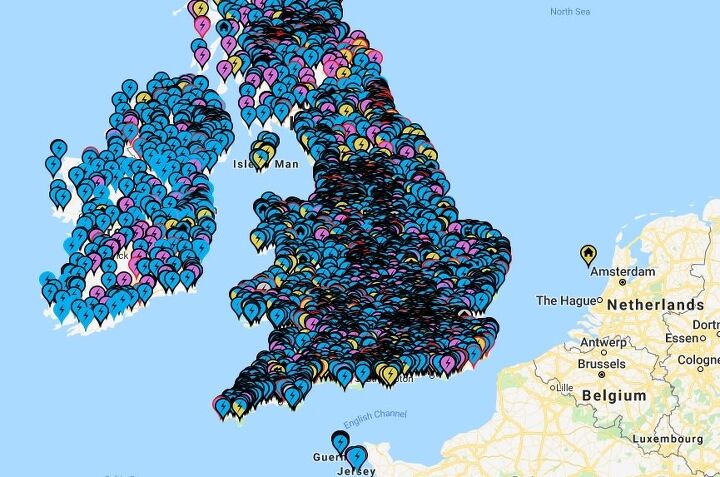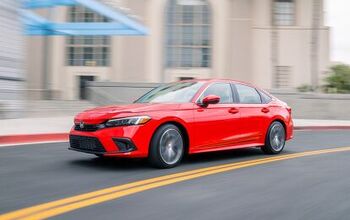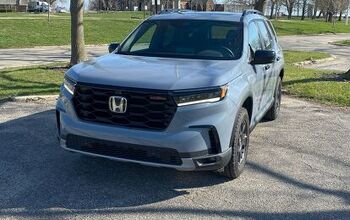Fueling Stations Reach Parity in UK As Subsidy Cut Sinks Plug-in Hybrids

The United Kingdom, a highly populous (and heavily taxed) country that’s smaller than 11 U.S. states, may serve as a canary in the coal mine for electric vehicle adoption. If there’s enough places to charge up your EV, will buyers make the switch?
From across the pond comes news that, for the first time, the number of public electric vehicle charging stations has surpassed that of gasoline and diesel stations. It’s been a long road, as “normal” stations have been on a steady decline since 1970. EV stations popped up in earnest earlier this decade, fueled by government investments and green group initiatives, as well as efforts by automakers eager to provide fuel sources for their new vehicles.
Battery-electric vehicle market share in the UK in July? 1.4 percent.
Whoa, whoa, you say — Not fair! BEVs haven’t even been on the road for a decade. It’ll take time to weed out the old crowd!
For sure. No argument. And indeed, recent introductions like the Tesla Model 3 and Hyundai Kona Electric offer driving ranges that far surpass that of previous “attainable” EVs. Still, England is not known for its massive driving distances, and was the first country on the planet to consider itself well served by rail transport.
It’s been a decade of flux in the UK and the rest of Europe. Whereas diesel was once the celebrated, commonplace, less-taxed fuel option, that’s all gone the way of Britpop. The Volkswagen diesel scandal left a sour taste in the mouth of legislators; in the scandal’s wake, new taxes popped up on the fuel in an attempt to dissuade buyers from choosing an oil burner for their commuting vehicle. Sales plummeted.
At the same time, every more stringent continent-wide emissions standards came into effect, and will continue to do so. To protect their own existence, automakers quickly turned away from diesel for lofty MPGs and invested in battery propulsion. We’re beginning to see that tide wash up on shore in earnest.
And yet even with all of these forces working against traditional internal combustion cars, an overnight explosion in BEV ownership did not occur, nor would anyone expect it. One problem: recharging infrastructure. In 2018, the country hosted 6,699 public charging stations of some sort (it could be a slow charger or the speediest in the land). Now, just a year later, the country’s Energy Institute (via Autocar) reports that 9,199 stations exist, outnumbering the UK’s 8,396 gas stations. See above for a location map. (It’s worth mentioning that a charging station may only be capable of handling one vehicle at a time. Show me a modern gas station that does that.)
Clearly, no shortage of investment went into making the technology viable for consumers in the past few years. Still, the public rebelled against the country’s cut in consumer subsidies late last year, and it seems the loss of taxpayer cash has resulted in the elevation of one type of vehicle and the looming death of another.
Last October, the UK government cut the BEV subsidy from 4,500 pounds (about $5,450) to 3,500 pounds ($4,240) and eliminated the plug-in hybrid subsidy ($3,030) altogether. Guess what happened? People went where the free money was, even if in many cases it meant a slightly pricier car, or decided to save cash. Gas in the UK is incredibly expensive, keep in mind.
According to The Guardian, “electrified” vehicles (BEVs, hybrids, plug-in hybrids) fell on a year-over-year basis in June, the first time the segment recorded a monthly decline since April of 2017. That figure hides key info, however. In June, BEV sales rose 61.7 percent while PHEVs sank by roughly half compared to the previous June, and July’s figures show a continuation of the trend.
Last month, the country recorded a 158 percent year-over-year increase in BEV sales, pushing their market share from 0.5 percent in 2018 to 1.4 percent. That’s a significant jump. Plug-in hybrids fell 49.6 percent, lowering their market share from 2.1 percent to 1.1 percent. Plain-Jane hybrid sales, which never benefited from a subsidy, rose over 34 percent for the month. Regular hybrids amounted to just under 5 percent of last month’s UK auto sales.
It seems people who would have bought a plug-in are giving in and deciding to go greener, or taking the cheaper route by going slightly less green. Diesel vehicles, for what it’s worth, continue to slide, with deliveries down 22.1 percent in July. Market share for diesel, which just a handful of years ago topped 50 percent, now stands at 25.9 percent.
Year to date, fully electric vehicle sales are up over 70 percent, hybrids are up over 19 percent, and plug-in hybrids have fallen by more than 32 percent.
What does this all prove? The green car industry, even in a favorable market, can’t count on boffo business without help. Subsidies to sweeten the deal, readily available public infrastructure, and a host of regulations (and associated taxes, fees, and fines) to strongarm consumers and companies in the right direction.
It makes you wonder about the United States, which so many automakers see as fertile ground for green conquest. Can there be any doubt as to why so many people have a less than optimistic outlook on a rapid consumer conversion?
[Image: Fiat Chrysler Automobiles, zap-map.com]

More by Steph Willems
Latest Car Reviews
Read moreLatest Product Reviews
Read moreRecent Comments
- Brian Uchida Laguna Seca, corkscrew, (drying track off in rental car prior to Superbike test session), at speed - turn 9 big Willow Springs racing a motorcycle,- at greater speed (but riding shotgun) - The Carrousel at Sears Point in a 1981 PA9 Osella 2 litre FIA racer with Eddie Lawson at the wheel! (apologies for not being brief!)
- Mister It wasn't helped any by the horrible fuel economy for what it was... something like 22mpg city, iirc.
- Lorenzo I shop for all-season tires that have good wet and dry pavement grip and use them year-round. Nothing works on black ice, and I stopped driving in snow long ago - I'll wait until the streets and highways are plowed, when all-seasons are good enough. After all, I don't live in Canada or deep in the snow zone.
- FormerFF I’m in Atlanta. The summers go on in April and come off in October. I have a Cayman that stays on summer tires year round and gets driven on winter days when the temperature gets above 45 F and it’s dry, which is usually at least once a week.
- Kwik_Shift_Pro4X I've never driven anything that would justify having summer tires.



































Comments
Join the conversation
Good read on magical thinking https://www.manhattan-institute.org/green-energy-revolution-near-impossible
Is it the same country that takes pride in making gas guzzling monsters and land yachts like RR, Bentley, Land Rover, Jaguar?